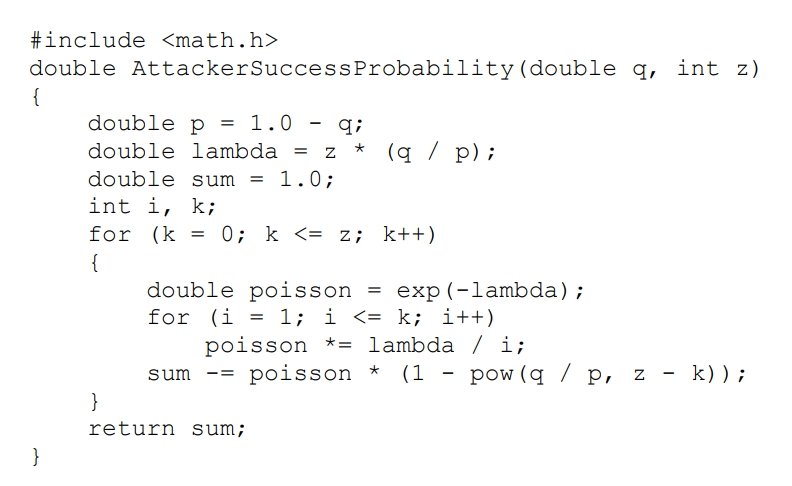Even if the attacker succeeds, the system is designed to prevent arbitrary changes such as creating value out of thin air or stealing money that doesn’t belong to them.
This is because nodes will not accept invalid transactions or blocks.
He then compares the race between the honest chain and an attacker chain to a Binomial Random Walk, where the success event is the honest chain being extended by one block and the failure event is the attacker’s chain being extended by one block.
The probability of an attacker catching up from a given deficit can be calculated using a Gambler’s Ruin problem, which is similar to a gambler with unlimited credit trying to reach breakeven after starting at a deficit.
The probability of the attacker catching up with the honest chain is thus calculated.
The Bitcoin system is designed to prevent fraudulent transactions, where someone tries to create value out of thin air or take money that they never owned.
To accomplish this, transactions are publicly announced to everyone in the network, and they are validated by the nodes, which are essentially computers that run the Bitcoin software.
Nodes ensure that a transaction is valid by checking that the sender actually owns the Bitcoin they are trying to spend and that the transaction hasn’t already been spent.
To further prevent fraud, Bitcoin uses cryptography to secure transactions.
Every transaction is signed with a private key, which only the owner of the Bitcoin has access to.
Anyone can verify that the transaction is signed correctly by using the corresponding public key, which is publicly available.
Bitcoin transactions are grouped into blocks, which are linked together in a chain.
This creates a ledger of all transactions that have ever occurred in the Bitcoin network, known as the blockchain.
Each block in the chain contains a hash, which is a unique code generated from the transactions in the block.
The hash of a block also includes the hash of the previous block in the chain, which links all the blocks together.
To ensure that the blockchain is secure and accurate, new blocks are added to the chain through a process called mining.
Miners use their computers to solve complex mathematical problems that validate new transactions and add them to the blockchain.
This is a competitive process, and the first miner to solve the problem and add a new block to the chain is rewarded with new Bitcoin.
One potential problem with the Bitcoin system is the possibility of a malicious actor, or attacker, trying to create a fraudulent blockchain that is longer than the honest blockchain.
This would allow the attacker to spend Bitcoin that they don’t own, essentially creating new Bitcoin out of thin air.
However, the Bitcoin system has safeguards in place to prevent this from happening.
The probability of an attacker successfully creating a fraudulent blockchain decreases exponentially as the number of blocks they need to catch up with increases.
This is because the honest blockchain is constantly growing and adding new blocks, making it increasingly difficult for an attacker to catch up.
Even if the attacker does manage to create a longer blockchain, the nodes in the network will only accept the longest chain as valid, meaning the attacker’s chain will be rejected.
To prevent a malicious sender from changing a transaction after it has been sent, the recipient of a new transaction waits until the transaction has been added to a block and several more blocks have been linked after it. The more blocks that are added to the chain after a transaction, the more difficult it becomes for an attacker to change the transaction. This ensures that the recipient can be confident that they have received the Bitcoin and that the transaction is final.
